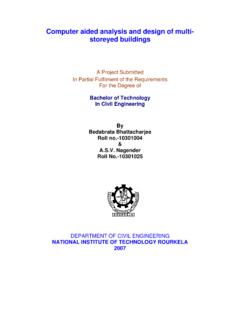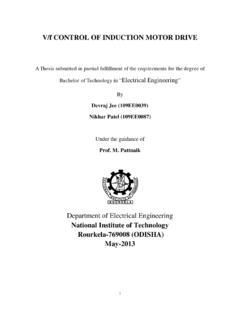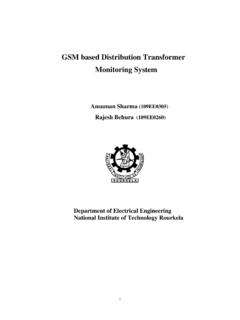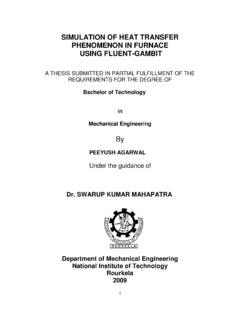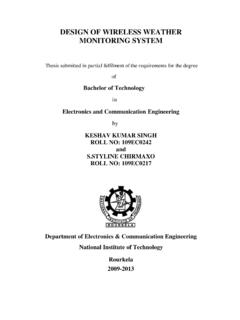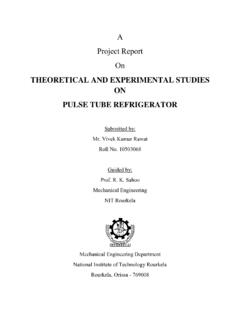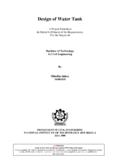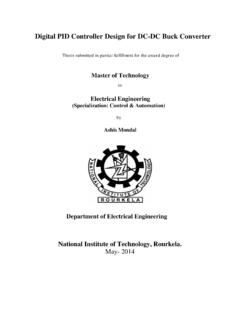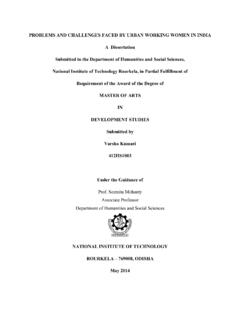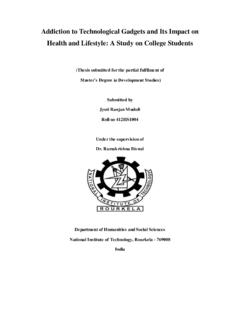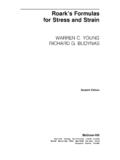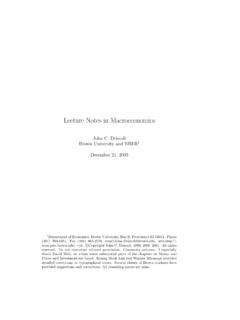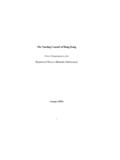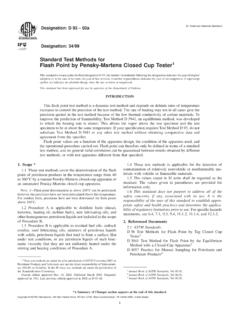Transcription of Modelling and Simulation of ethyl acetate reactive ...
1 Modelling and Simulation of ethyl acetate reactive distillation column using ASPEN PLUS A Project submitted to the National Institute of Technology, Rourkela In partial fulfilment of the requirements of Bachelor of Technology (Chemical Engineering) By Shyam Kumar Roll No. 10600032 Under the guidance of Prof. (Dr) B. Munshi DEPARTMENT OF CHEMICAL ENGINEERING NATIONAL INSTITUTE OF TECHNOLOGY, ROURKELA ORISSA -769 008, INDIA 2010ii DEPARTMENT OF CHEMICAL ENGINEERING NATIONAL INSTITUTE OF TECHNOLOGY, ROURKELA -769 008, INDIA CERTIFICATE This is to certify that the thesis entitled Modeling and Simulation of ethyl acetate reactive distillation Column Using ASPEN PLUS, submitted by Shyam Kumar to National Institute of Technology, Rourkela is a record of bonafide project work under my supervision and is worthy for the partial fulfillment of the degree of Bachelor of Technology (Chemical Engineering) of the Institute.
2 The candidate has fulfilled all prescribed requirements and the thesis, which is based on candidate s own work, has not been submitted elsewhere. Supervisor Prof. (Dr) B. Munshi Department of Chemical Engineering National Institute of Technology Rourkela - 769008 INDIA iii ACKNOWLEDGEMENT I wish to express my sincere thanks and gratitude to Prof Dr. B. Munshi for suggesting me the topic and providing me the guidance, motivation and constructive criticism throughout the course of the project. I must also thank Prof. H. M. Jena for acting as the project coordinator. I am also grateful to Prof. (Dr.) S. K. Agarwal, Head of the Department, Chemical Engineering for providing me the necessary opportunities for the completion of my project.
3 I also thank other staff members of my department for their invaluable help and guidance. Shyam Kumar Roll No. 10600032 , 7th semester Chemical Engineering iv ABSTRACT In this thesis, we study the modeling and Simulation of a reactive distillation column for the production of ethyl acetate from acetic acid and ethyl alcohol using ASPENPLUS. Starting from a conventional configuration, which involves feeding in a single tray, different configuration is proposed and various specifications are studied for the attainment of higher conversion and purity at the steady state.
4 In ASPEN DYNAMICS an analysis of the column dynamics is then performed. Cascade control structure is studied for the base design. v CONTENTS Cover page i Certificate ii Acknowledgement iii Abstract iv Contents v List of figures vi List of tables vii Nomenclature viii 1. Introduction and Literature Background of reactive distillation 2 Commercial applications of reactive distillation 3 Advantages of reactive distillation 4 Constraints and disadvantages of reactive distillation 5 Properties and uses of ethyl acetate 5 Production of ethyl acetate 7 ASPEN PLUS software 8 Aspen Dynamics 9 2. Modeling 10 3. Steady state Simulation Configuration-1 17 Configuration-2 23 Configuration-3 25 Configuration-4 28 vi 4.
5 Dynamic Simulation Installing level controller 34 Installing flow controller 35 Installing temperature controller 35 Installing composition controller 36 Cascade Control Structure 36 Performance Evaluation of Control Structure 37 5. Conclusion 39 References 40 List of figures: Figure no. Description Page no. Configuration for reactive - distillation column 11 General reactive - distillation stage 12 Single feed Flow diagram in aspen plus user interface for reactive distillation 18 Stage wise Composition profile 18 Stage wise temperature profile 19 Effect of reflux ratio on liquid composition of ethyl acetate 19 Effect of distillate flow rate on liquid composition of ethyl acetate in distillate and bottom 21 Effect of total no of stages in column on liquid composition of ethyl acetate in distillate and bottom 22 Composition profile of ethyl acetate in liquid phase for different activity model 23 Double feed Flow diagram in aspen plus user interface for 24 vii reactive distillation Double reactive distillation column diagram in aspen plus user interface 25 Stage-wise liquid composition profile of ethyl acetate in RD-1
6 And RD-2 26 Stage-wise liquid composition profile of ethyl acetate in RD-1 and RD-2 with different feed location 27 reactive distillation column with heated side-stream in aspen plus user interface 28 Initial screen in Aspen Dynamics for single column with single feed 33 Configuration-1 with cascade control structure in ASPEN DYNAMICS 37 Dynamic response of composition in bottom and distillate subjected to feed flow disturbance 37 Dynamic response of composition in bottom and distillate subjected to feed composition disturbance 38 Dynamic response of composition in bottom and distillate subjected to distillate set-point disturbance 38 List of tables: Table 1( Simulation result for changing distillate flow rate on composition) 20 Table 2( Simulation result for changing total no of stages in column on composition) 21 Table 3( Simulation results for different activity model on composition) 22 Table 4 ( Simulation result for double feed reactive distillation column) 25 Table-5(study result of varying T across Heat Exchanger on composition) 30 Table 6,(a,b)(study result of pumparound return location on composition) 31 viii Nomenclature.
7 A = The Arrhenius pre-exponential factor for the pth term Ep = Energy of activation for the pth term Ei= The discrepancy (residual) of the energy equation for stage i f i,j = Liquid component molar flow for component j in the fresh feed to stage i Fi= , g i, j = Vapor component molar flow for component j in the fresh feed to stage i G i= g , Hi = Enthalpy of the primary vapor leaving stage i; not including the vapor sidestream HG i = Enthalpy of Gi hi= Enthalpy of the primary liquid leaving stage i; not including the sidestream or entrained liquid hF i= Liquid enthalpy of F, K i,j = Vapor-liquid equilibrium ratio for component j on stage i i,j = Moles of component j in the primary liquid leaving stage i ; not including sidestream liquid or entrained liquid Li = , M i, j = Discrepancy (residual) of the component material balance for component j and stage i N = Number of stages including condensers and reboilers NRX= Number of chemica1 reactions Pi = Pressure on stage i Qi= Heat duty at stage i Si = Ratio of vapor drawoff to primary vapor (vapor not withdrawn or entrained )on stage i =W i/V i si = Ratio of liquid drawoff to primary liquid (liquid not withdrawn or entrained)on stage i =P i / Li Ti= Temperature on stage i Ui = Liquid holdup on stage i i,j = Moles of component j in the primary vapor leaving stage i.
8 Not including sidestream vapor ix V i= , i,j=Stoichiometric coefficient for component j in chemical reaction n r , =reaction rate for reaction n on stage j,as the increase in moles of a reference reactant per unit time per unit volume of liquid phase xj = Mol-fraction in liquid of component j yj= Mol-fraction in vapor of component j xi,j = Mol-fraction in liquid of component j at stage i yi,j= Mol-fraction in vapor of component j at stage i 1 CHAPTER-1 INTRODUCTION AND LITERATURE 2 Chapter-1 Introduction and literature reactive distillation involves simultaneous chemical reaction and distillation . The chemical reaction usually takes place in the liquid phase or at the surface of a solid catalyst in contact with the liquid phase [1]. General application of reactive distillation is the separation of a close-boiling or azeotropic mixture described by Terril et al.
9 [2]. A second application of reactive distillation involves taking into account undesirable reaction that may occur during distillation but the most interesting application involves combining chemical reactions and separation by distillation in a single distillation apparatus [1] The technique offers a key opportunity for improving the structure of a process. It is a so-called hybrid process, it merges two different unit operations in a single apparatus, namely reaction and distillation . But the combination of distillation and reactions is possible only if the conditions of both unit operations can be combined. reactive distillation can be used with a wide variety of chemistries, including the following: Acetylation, Aldol condensation, Alkylation, Amination, Dehydration, Esterification, Etherification, Hydrolysis, Isomerization, Oligomerization, Transesterification.
10 Background of reactive distillation : reactive distillation , combination of chemical reaction and multicomponent distillation in a single unit, has proven to be advantageous over conventional process systems consisting of separate reactor and distillation unit. Prior to the advent of digital computers, the literature dealt mainly with proposed applications and simplified calculational procedures. This concept appears to have been first pronounced by Backhaus, who, starting in 1921, obtained a series of patents for esterification reaction in a distillation column. This concept of continuous and simultaneous chemical reaction and distillation in a single vessel was verified experimentally by Leyes and Othmer, for the esterification acetic acid with an excess of n-butanol in the presence of sulfuric acid catalyst to produce butyl acetate and water.
